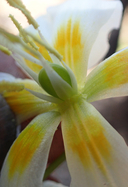Taxon Details
Erythronium oregonum
giant fawn lily
View Report Copy Link Calflora eFlora CCH CalPhotos iNaturalist
Taxon Summary:
Erythronium oregonum, commonly known as giant fawn lily, is a perennial herb in the Liliaceae that is found in California and elsewhere. It occurs within Cismontane woodland, and Meadows and seeps, growing at elevations from 100 to 1150 meters. Erythronium oregonum is ranked 2B.2, Plants Rare, Threatened, or Endangered in California, But More Common Elsewhere; Moderately threatened in California.|
Scientific Name: Erythronium oregonum Appleg. |
||
|
Common Name: giant fawn lily |
||
| Family: | Liliaceae | |
| Element Code: | PMLIL0U0C0 | |
| USDA Plants Symbol: | EROR4 | |
|
Synonyms/Other Names: |
||
| Name Status: |
JEF, FNA, POWO, IPNI, Tropicos |
|
| CA Rare Plant Rank: | 2B.2 |
| Fed List: | None |
| State List: | None |
| Global Rank: | G5 |
|
State Rank: |
S2 |
| Other Status: | SB_UCSC |
|
CRPR Changes: added to 2.2 on 2007-07-23 |
|
| Add Date: | 2007-07-23 |
| Date Edited: | 2025-10-29 |
| Lifeform: perennial herb | ||||||||||||||
Blooming Period: Mar-Jun(Jul)
|
||||||||||||||
|
Elevation:
100 - 1150 meters 330 - 3775 feet |
||||||||||||||
General Habitats:
|
||||||||||||||
| Microhabitat Details: | ||||||||||||||
Microhabitat:
|
||||||||||||||
|
Notes: Need quad for TRI Co. Threatened by horticultural collecting, road maintenance, and logging. Possibly threatened by trampling. California populations are geographically separate; may be a white form of E. revolutum. Specimens with white anthers sometimes referred to as ssp. leucandrum. See Madrono 3: 99 (1935) for original description and Madrono 35(1): 32-38 (1988) for taxonomic treatment. |
|
|
Threats: |
|
|
Taxonomy: |
|
| Threat List Total: | 9 | |
| Total EOs | % of EOs | |
| EOs with Threat Listed: | 17 | 46 % |
| THREAT LIST: | ||
|---|---|---|
| Logging | 15 | 40% |
| Road/trail construction/maint. | 12 | 32% |
| Other | 6 | 16% |
| Foot traffic/trampling | 5 | 13% |
| Wood cutting or brush clearing | 4 | 10% |
| Erosion/runoff | 3 | 8% |
| Grazing | 1 | 2% |
| Over-collecting/poaching | 1 | 2% |
| Recreational use (non-ORV) | 1 | 2% |
| Total Occurrences: | 37 | ||||
| Element Occurrence Ranks: | |||||
|---|---|---|---|---|---|
| A | B | C | D | X | U |
| 4 | 10 | 4 | 0 | 0 | 19 |
| Occurrence Status: | |||||
|---|---|---|---|---|---|
| Historical >20 Years | 15 | ||||
| Recent <=20 Years | 22 | ||||
| Presence: | |||||
|---|---|---|---|---|---|
| Presumed Extant | 37 | ||||
| Possibly Extirpated | 0 | ||||
| Presumed Extirpated | 0 | ||||
| California Endemic: | |||||||||||||
| California Island: | |||||||||||||
|
States: Name (Code) California (CA), Oregon (OR), Washington (WA) |
|||||||||||||
|
California Counties and Islands: Name (Code) Del Norte (DNT), Humboldt (HUM), Siskiyou (SIS) |
|||||||||||||
|
Quads: Name (Quad Code) Blue Creek Mtn. (4112347), Blue Lake (4012388), Cecilville (4112322), Ettersburg (4012328), Fish Lake (4112336), Gasquet (4112378), Grouse Mtn. (4012376), Hiouchi (4112471), Hoopa (4112316), Hupa Mountain (4112317), Iaqua Buttes (4012368), Johnsons (4112337), Lord-ellis Summit (4012387), Myers Flat (4012337), Panther Creek (4112318), Scotia (4012441), Somes Bar (4112344), Taylor Peak (4012442), Tish Tang Point (4112315), Willow Creek (4012386), Yager Junction (4012357) |
|||||||||||||
Notes:
|
|||||||||||||
 Presumed Extant
Presumed Extant
Click on quad for name. Hold Shift Key to use mouse scroll wheel



